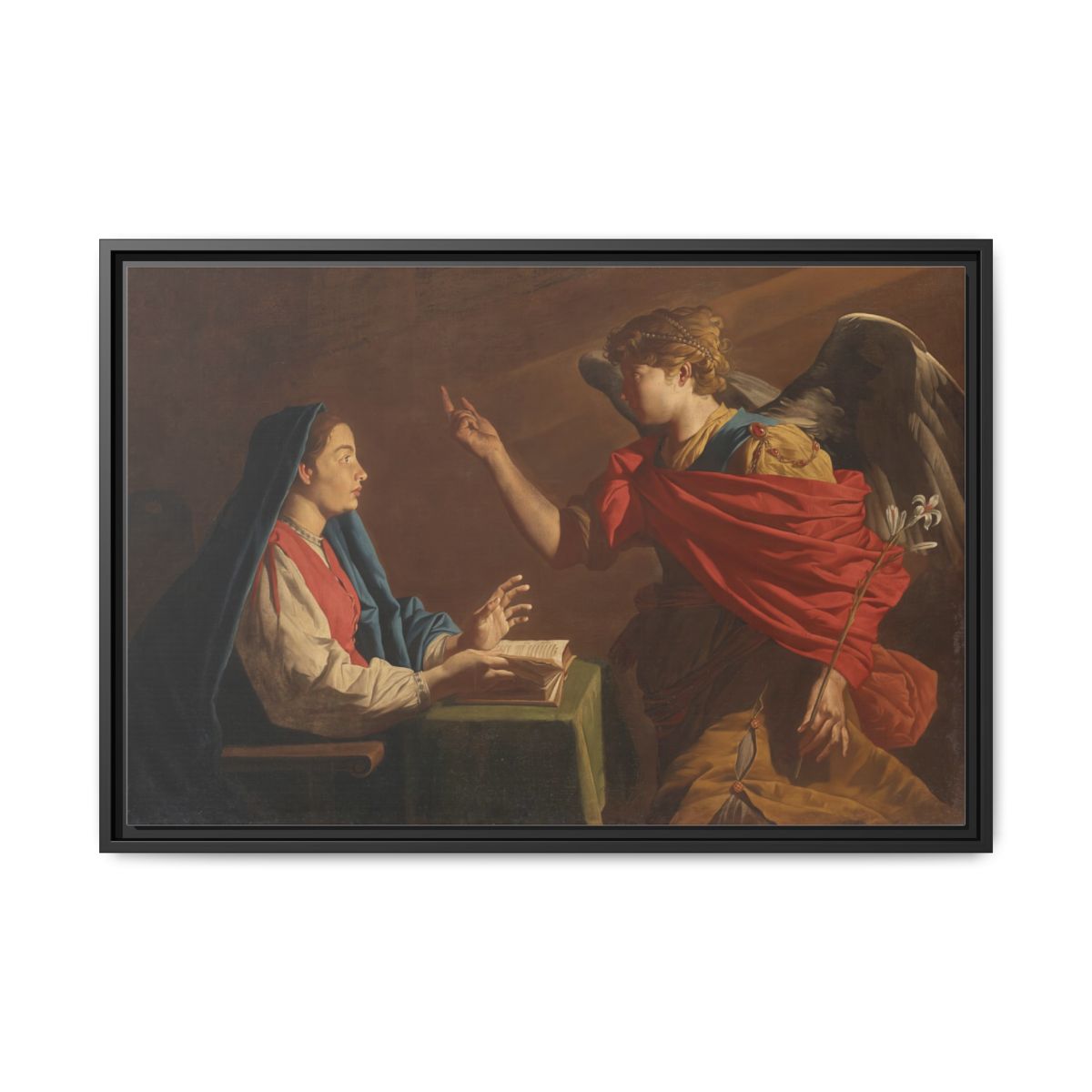The Annunciation
Artist: Matthias Stom
Description: "The Annunciation" by Matthias Stom is a Baroque oil painting depicting the angel Gabriel and Virgin Mary, highlighting a key moment in Christian history.
Price: Select options to see price
Product Option:
Why You'll Love It
The Annunciation by Matthias Stom: An Artistic and Spiritual Exploration
Matthias Stom, also known as Matthias Stomer, stands as a prominent figure among 17th-century Northern European painters who found inspiration and success in Italy. His painting, The Annunciation, executed in oil on canvas, is a compelling synthesis of Dutch realism and the dramatic illumination characteristic of the Italian Baroque. This work not only embodies Stom’s mastery but also serves as a crucial visual document within Christian religious art.
The Artist: Matthias Stom
Born in the early 1600s in the Northern Netherlands, Matthias Stom aligned himself with the Caravaggisti, a group of artists deeply influenced by the intense naturalism and stark emotional contrasts pioneered by Caravaggio. By the mid-1620s, Stom had moved to Italy, spending significant periods in Rome, Naples, and Sicily. His works, characterized by passionate spirituality and dramatic use of light, gained recognition for blending northern attention to detail with southern theatricality. Stom specialized in religious subjects, bringing biblical stories to life with immediacy and psychological depth.
Historical Context
The Annunciation was painted during the height of the Catholic Counter-Reformation, around the 1630s. This era saw renewed emphasis on vivid religious imagery aimed at inspiring devotion among the faithful. Art became a powerful tool for spiritual engagement, and Stom’s The Annunciation reflects both the religious fervor of the period and the evolving artistic trends that prioritized emotional impact and accessibility.
Stom was working in Italy at a time when both Catholic patrons and private collectors sought paintings that personalized sacred narratives. His proximity to leading artistic hubs exposed him to major innovations in genre, composition, and technique, all echoing in his rendition of the Annunciation scene.
Religious and Cultural Significance
The Annunciation—Gabriel’s declaration to the Virgin Mary that she would conceive Jesus Christ—occupies a central position in Christian theology. It signifies the Incarnation, emphasizing divine intervention in human history and Mary’s humble obedience. For the faithful, this event marks God’s commitment to redemption, portrayed through the young woman’s acceptance of her destiny.
Stom’s treatment of the subject adheres to iconographic traditions recognized throughout the Christian world, yet it resonates with Baroque intensity. The painting, intended for contemplation, becomes both a devotional image and a theological lesson, reminding viewers of the miraculous and the intimate interplay between the divine and the mundane.
Symbolism and Iconography
In Stom’s The Annunciation, symbolism is wielded with both restraint and clarity. Gabriel, often depicted as otherworldly, takes on a human warmth: his presence illuminated, but not overpowering, as he addresses Mary. The Virgin, clad in the traditional blue that symbolizes purity, draws the audience’s gaze through a gentle gesture or focused expression.
Key iconographic elements include:
- The Lily: Present either in Gabriel’s hand or within the pictorial space, signifying the Virgin’s purity.
- A Ray of Light or Dove: Represents the Holy Spirit’s descent, marking the moment of divine conception.
- Book or Prayer Shawl: Alludes to Mary's piety, her absorption in scripture, and her readiness to receive the Word.
Stom’s preference for tenebrism (dramatic contrasts of light and dark) heightens the sense of revelation, casting both figures in an aura that speaks to spiritual enlightenment.
Artistic Techniques
Stom’s artistry is deeply informed by Caravaggesque techniques. His command over chiaroscuro—the interplay of light and shadow—renders the Annunciation scene both theatrical and intimate. The focused illumination on Mary and Gabriel isolates their encounter against a subdued background, imparting visual and emotional intensity.
Notable techniques in The Annunciation include:
- Realistic Rendering: Stom’s Northern European roots surface in his meticulous depiction of fabrics, hands, and faces.
- Dramatic Lighting: Light is utilized to signify spiritual presence, falling sharply to emphasize gesture and expression.
- Night Scene Setting: The nocturnal ambiance points to the mystery of the event, reinforcing the painting’s spiritual message.
- Compositional Balance: Attention to symmetry creates a harmonious arrangement, with dynamic diagonals leading the eye from Gabriel’s announcement to Mary’s receptive posture.
These elements combine to foster an atmosphere of awe and contemplation, inviting viewers to witness the sacred event as if present.
Cultural Impact
Since its creation, Stom’s The Annunciation has been appreciated not only for its religious resonance but also as a testament to the cross-cultural exchanges shaping 17th-century European art. Its presence in collections and museums underscores its lasting influence. As a work by a Dutch artist working in the Italian Baroque idiom, the painting bridges North and South, Protestant heritage and Catholic patronage.
Art historians have noted Stom’s influence on later Neapolitan painters and Northern followers of Caravaggio. The painting’s style and devotional power have ensured its regular reproduction in art books, exhibitions, and scholarly discussions of Baroque religious art.
Sources
- “Matthias Stom and the Caravaggisti,” The National Gallery, London.
- Benedict Nicolson, Stomer (Matthias Stom), The Burlington Magazine, 1962.
- “The Annunciation in Art,” The Metropolitan Museum of Art Heilbrunn Timeline.
- Francesca Curti, Matthijs Stom: un maestro caravaggesco tra Napoli, Roma e Sicilia, Franco Cosimo Panini Editore, 2015.
- Rudolf Wittkower, Art and Architecture in Italy, 1600-1750, Pelican History of Art, Yale University Press.
Who Made It
Created by Matthias Stom.
All Available Options
Below is a list of all the available options for this product. If you don't see what you're looking for, please contact us.
Shipping & Returns
All items are custom-made just for you! We partner with JonDo for fulfillment, and your order will typically arrive within 2-5 days. Since each piece is crafted to order, we don't offer returns, but we've got your back—if there's a defect or an issue caused by us or shipping, we'll do our absolute best to make it right. Questions? Feel free to reach out!
